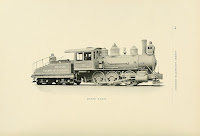 |
Snoqualmie Landmarks Commission,
key Landmarks staff, and Museum
Executive Director Richard Anderson
pose for a post-vote photo in the
Snoqualmie council chambers.
|
The staff report made a number of interesting observations
about locomotive 924:
 |
Catalog cut from the Rogers Locomotive
Company catalog of 1900.
|
- The NPR Locomotive 924 is significant under (King County Landmarks) Criterion A1 for its association with the growth and development of King County. Locomotives were the engine of the industrial revolution and western expansion, and the Northern Pacific Railway (NPR) was instrumental in setting broad patterns of settlement and development in King County and across the northern portion of the country from Minnesota to Washington. NPR 924 served this railway for twenty-five years.
- NPR 924 is significant under Criterion A3 as an excellent and rare example of a classic late 19th century steam locomotive. It features many of the common elements of both larger and smaller locomotives, and in many respects was “state of the art” for the era. There are very few locomotives originally owned by mainline railroads that survived beyond WW II.
- NPR 924 is also significant under Criterion A5 as an outstanding and rare example of a switching locomotive constructed by Rogers Locomotive Company in Paterson, New Jersey, the second largest builder of steam locomotives in America. Rogers was an innovative manufacturer who developed many features that became common – or even standard – on nearly all steam locomotives. Rogers produced more than 6,000 locomotives. Only 20 known examples remain world-wide; 11 of those are in the United States.
 |
924 at Millwood, WA, after retirement
from the Northern Pacific.
|
The Landmark Register is an important initiative of King
County, which is one of the largest counties in the United States. A King County Historic Preservation Officer –
Jennifer Meisner - is appointed by the King County Executive. Under her direction is a full
time staff in the King County Historic Preservation Program that provides technical advice, project impact reviews for public
agencies, and Interlocal landmark programs for suburban cities including
Snoqualmie and North Bend. Other objects
on the Landmarks Register at the Northwest Railway Museum include Chapel Car 5 Messenger of Peace, Northern Pacific Railway rotary snowplow 10, and the
Northern Pacific Railway/Seattle Lake Shore and Eastern Snoqualmie Depot.







